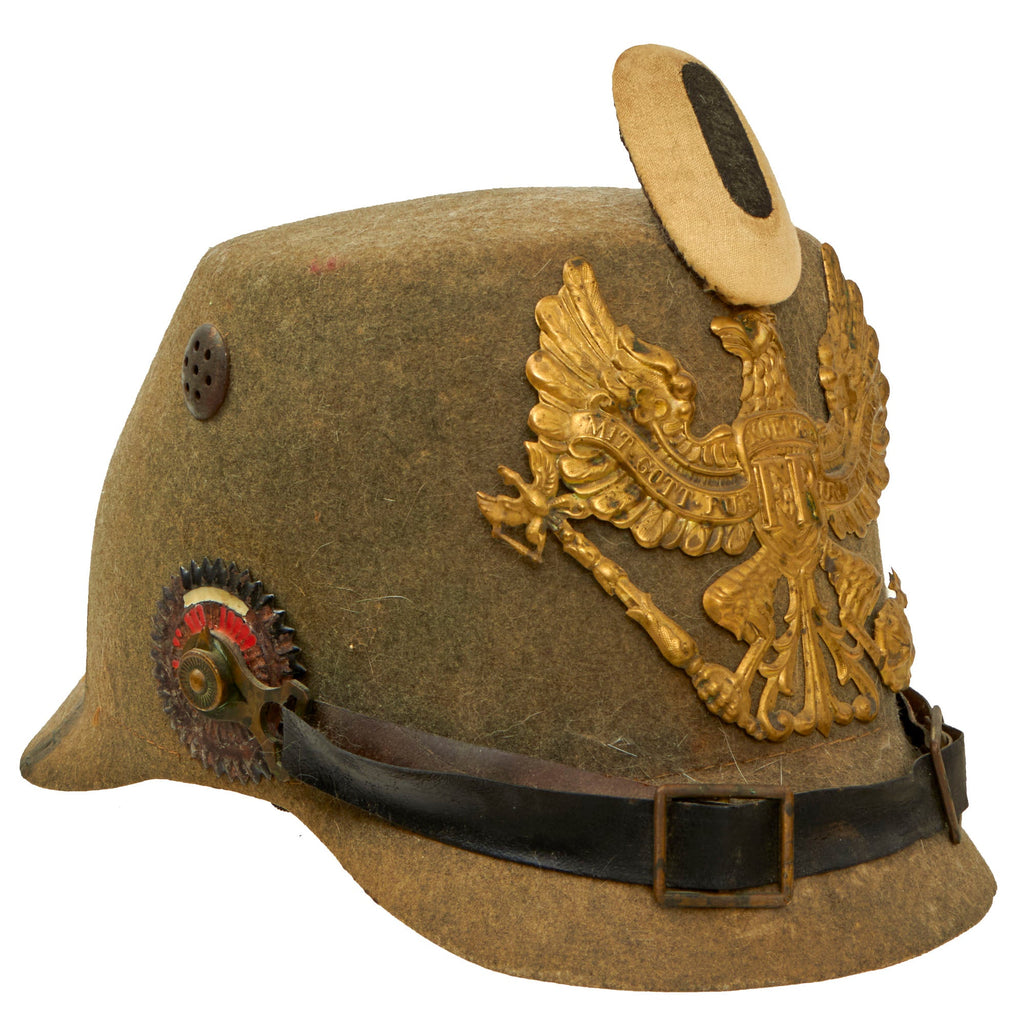Item Description
Original Item: Only One Available. This is the first time we have had one of these scarce simplified pattern Ersatz Felt Shakos! Not only is this a scarce model to obtain, let alone one in such appealing condition! When WWI broke out, there was a great need for additional helmets and equipment for the mobilization. A shortage of cow hide from Argentina combined with the excessive draw upon German industry to outfit the massive army being mobilized, resulted in a severe shortage of leather for manufacturing Pickelhauben and shakos alike. To meet with this immediate shortage, the Germans began in 1914 manufacturing helmets from Ersatz (substitute) materials.
As the felt hat manufacturing industry was well established in Germany for hundreds of years, the hat industry stepped in to fill the void by producing Pickelhaube/Shakos out of pressed and blocked felt, manufactured from rabbit fur or shredded wool. One advantage to the Filzhelme (felt helmets) was that they were normally pressed from one-piece of felt which significantly reduced production time. There were many variations produced, depending on when they were made and what materials for fittings were available at the time. First the brass M1895 fittings were used up, and then in 1915 the Filzhelm switched to the oxide coated steel, like this one. There are many examples of Ersatz helmet with both brass and steel fittings like this one.
This is an excellent original Imperial Prussian Jäger enlisted man's Mannschaften (other ranks or EM / NCO) Felt Tschako (Shako). The M1915 was the last model of Tschako issued prior to the move to steel helmets, and replaced the earlier M1895 and M1897 patterns. In accordance with the 1915 regulations, these helmets would no longer use brass, silver, or Tombak as earlier versions did. All issued leather helmets would now use gray oxidized steel fittings for all Regiments. As with previous versions, the body was constructed from boiled leather, which was shaped and lacquered black. Towards the end of the M1915 line, the need for these leather shakos went through the roof, resulting in these pressed Ersatz (replacement) felt shakos until the switch to steel headgear.
This is an excellent textbook example, and features a steel brass color finished Prussian wappen (front plate), which features the state eagle clutching a scepter and crown, over the King's motto, MIT GOTT FÜR KOENIG UND VATERLAND (With God for King and Country, i.e. Prussia). It is held in place by the standard metal wire on the inside of the shell. Both M1891 pattern side lugs are present, and the right and left side has a very nice German National Colors (red white and black) Kokarde (cockade) around the lugs with a solid chinstrap still attached.
In 1897 the new Reichs-Kokarde in Red-White-Black was introduced for all ranks to commemorate the 100th anniversary of the birth of Kaiser Wilhelm 1st. The Reichs-Kokarde was to be worn on the right side of the helmet. As Tschako helmets feature a front cockade, there is wasn’t normally a cockade on the left chin strap lug though there is present present here. This helmet still has its correct Prussian (Black & White) removable felt covered cockade at top front.
The interior features a nice original leather liner, which shows heavy signs of original use, and age which accumulated over decades in storage. All fingers are mostly intact, and still have a few intact securing strap holes while most are torn. There are no markings we can find.
The exterior of the helmet shell is in good condition. Showing some signs of shrinkage (likely from languishing in a hot attic for decades). The front and rear visors are still attached as these were constructed from a single piece of material. The rear visor does have what appears to be an old repair done via thread and adhesive. The Tschako also has the correct 7 hole metal ventilation fittings on each side.
This is overall a great condition Prussian M1915 ErsatzTschako, which would make a great addition to any collection!
History of the Shako-
The word shako originated from the Hungarian name csákós süveg ("peaked cap"), which was a part of the uniform of the Hungarian hussar of the 18th century. Other spellings include chako, czako, schako and tschako.
From 1800 on the shako became a common military headdress, worn by the majority of regiments in the armies of Europe and the Americas. Replacing in most instances the light bicorne, the shako was initially considered an improvement. Made of heavy felt and leather, it retained its shape and provided some protection for the soldier's skull, while its visor shaded his eyes. The shako retained this pre-eminence until the mid-19th century, when spiked helmets began to appear in the armies of the various German States, and the more practical kepi replaced it for all but parade wear in the French Army. The Imperial Russian Army substituted a spiked helmet for the shako in 1844-45 but returned to the latter headdress in 1855, before adopting a form of kepi in 1864. Following the Franco-Prussian War of 1870, military fashions changed and cloth or leather helmets based on the German headdress began to supersede the shako in many armies.
Although the mid-nineteenth century shako was impressive in appearance and added to the height of the wearer, it was also heavy and by itself provided little protection against bad weather as most models were made of cloth or felt material over a leather body and peak. Many armies countered this by utilizing specially designed oilskin covers to protect the shako and the wearer from heavy rain while on campaign. The shako provided little protection from enemy action as the most it could offer was in giving partial shielding of the skull from enemy cavalry sabers.
- This product is available for international shipping.
- Eligible for all payments - Visa, Mastercard, Discover, AMEX, Paypal & Sezzle













